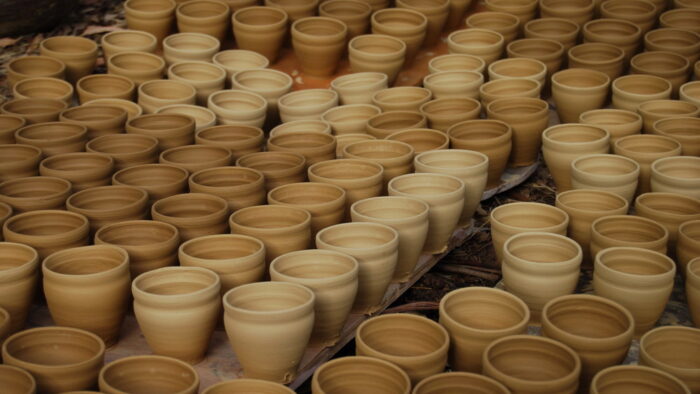Sandra Bowkett first visited India in 1988 to work on the archaeological site at Hampi. While travelling alone from Chennai to Hospet, first off the train system, was challenging, her stay at Hampi made Sandra fall in love with India. She then traveled north with some friends she met at the site. The further north she ventured to, the more she liked it. It was when she saw her first stack of matka in Jodhpur (and a photograph), she knew she would return to this country someday.
Sandra is a ceramist from Australia with over four decades of experience in Australian, Japanese and European pottery traditions. She has been working with Indian potters since 2002 and regularly organizes exchanges of Indian and Australian potters.
She “realized the prevalence of a romanticized view when language and visitor status is a barrier, protecting a traveler from a deeper understanding of what is going on. Vernacular, architecture, textiles and any artisan endevour” is a great way to break this barrier. In this interview, Sandra shares her experiences of traversing as well as curating pottery tours across India.
What makes Indian pottery different from other pottery styles such as ones more prevalent in Australia?
Australian First Peoples here did not have a culture of fired functional vessels. My cultural traditions are connected to western ceramic traditions although when I studied in the 70s Japanese/Korean aesthetic was the interest which is a similar history to the contemporary studio pottery movement in India.
Indian traditional pottery, on the other hand, has a history that is millennia old and is similar in form and technology that goes back to the Harappa. There has been evidence of terracotta pots possibly used for storing precious stones, grains or spices. Traditional potters have a family lineage that connects them to that past, the forms they are making have evolved and perfected by function and repetition of making over time. I think pottery is not usually a form of self-expression for traditional potters. Pottery vessels are integral to life. However, the importance of pottery in this is rapidly changing from what I have seen over 20 years of recent visits.
You have also facilitated exchange programs wherein Indian potters have visited Australia for skill training and knowledge sharing. How has that experience been?
Profound for myself and those attending activities. The grace with which the potters work and the forms made using techniques not used in Australia have mesmerized audiences. These are opportunities for Indian potters to make good money and have their skills applauded. However, for the visiting Indian potters generally what they see here is not appropriate technology transferable to their home workshops in India.
An exception to this was a potter Bhuvnesh Prasad, who had been practicing traditional pottery but was keen on experimenting with more high fired techniques. We worked together creating a series of pieces fired in my high firing woodfired kiln. This motivated him to rebuild some of his kilns.

From left: Manohar Lal, Sandra Bowkett, Ann Ferguson and Banay Singh
What excites you the most when curating an experiential tour around pottery? Are there some “must-have” experiences in your itinerary?
Exciting and nerve-racking would be initial days in Old Delhi. I am excited to be there and anxious how my guests will manage. It is most rewarding to be able to enable interactions. I know I am in a unique position to create and then witness the deep experience tourers have. I have also included a trip to Agra, although I would not do that again as it consumes too much time and energy and could easily be done through other agencies. I usually include other historical sites if nearby.
Must-haves are visiting families, I have come to call family, mostly in the pottery colonies of Uttam Nagar and nearby Kumhaargram (Vikas Nagar). This is where I feel comfortable that I can provide an intimate experience that connects directly with the authentic traditional pottery culture. We have also visited pottery communities in Rajasthan connected to Kumhaargram families. Our visits to the potter communities include demonstrations, the opportunity to have a go, food and chai. In Delhi, it is also important to visit contemporary potters and visit exhibitions. The contemporary scene is similar to that in Australia and it gives tourers the opportunity to see and speak with other ceramists.
I also ensure we have ‘local knowledge’ ie have Manohar Lal with us for our time in Alwar province and Shirley Bhatnagar as an English-Hindi speaker and cultural interpreter. She is a contemporary ceramist but also has a great interest in traditional pottery culture.
Venturing into the country side, staying in places that are architecturally or aesthetically interesting and stopping for eating or chai at spots that are not somewhere a bus of tourists would be stopping, are some other unique experiences of the tours.
Kulhar has been used in India for centuries. What are your thoughts on pottery from a sustainability and aesthetic point of view?
Kulhar is my particular passion, after matka. Sustainability, once the clay is fired it cannot be made clay again i.e. reused although it could be incorporated into other building materials, the firing of clay objects can also be polluting. But so is the making of plastic and polystyrene, cardboard uses trees unless made from recycled papers, plastic cups from recycled water bottles.
The making of kulhar maintains unique skills that make up the diversity of pottery culture. Aesthetically the vessels have evolved to pleasing forms from repetition in the making and the particular determinants for their use – size for chai, volume for lassi or hot milk, openness for sweet rice etc., I also like the regional variation to be found. Utility, the porous quality of low fired clay assists in taking moisture from some products to their advantage. Chai is best from kulhar….in my opinion.
What makes India a potential destination for crafts tourism particularly Indian pottery?
From my experience it is more about the culture of the specific group visiting India rather than gathering skills or technical information, being exposed to the fundamentals of ceramics can be a profound experience. In my tours, clay is the common language that enables a more authentic relationship with people we may meet. It is a way into India that is manageable with a specific focus. The same could be done through food or any of the other crafts.
Indian crafts have been such an important part of the culture, the making of essential items for life, craftspeople with expertise (although numbers are in decline) making extraordinary objects and should be valued. These artisans need to be supported to maintain these skills and the authenticity of the objects they make without selling out to commercialism. The value of being in the space of a living tradition, i.e seeing someone at work and being encouraged to pay appropriately for the experience, rather than acquiring a tourist object, could be encouraged.
What are some of the other initiatives that have contributed to India–Australia Crafts Exchange?
I think there are many initiatives in Australia for our small population. However, it is not always easy for Indians to come to visit Australia because of visas and other constraints. On the Indian side, one can look and even maintain a comprehensive register of all the ‘residencies’ available in India along with their details. Once the Australia India Council had an interest in funding creative ventures, this seems less so now.
I am not familiar with a lot of high levels exchanges other than what I see through Garland, World Craft Council and Asialink, for example. Monumental exhibitions etc are other ways to reach the creative communities. However, I think support for individuals to explore and share, in a ground up model is where I feel comfortable as it can be more inclusive of anyone interested in engaging with the other.
Images: Crosshatched





